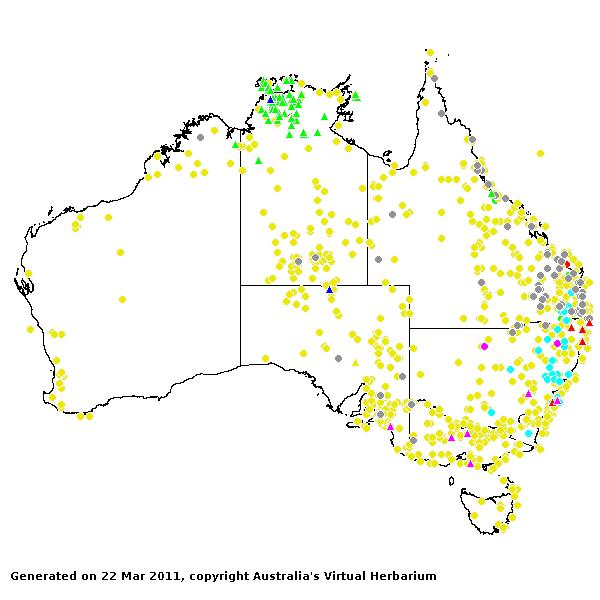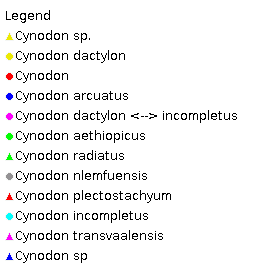Cynodon Syn. Pl. 1: 85 (1805).
Derivation:. From Greek kynos, genitive of kyon (dog) and odous (tooth), alluding to the toothlike buds of the rhizome.
Taxonomic revisions, nomenclatural references:. J.M.J. de Wet and J.R. Harlan, Taxon 19: 564–569 (1970); M.Lazarides, Austr. J. Bot. Supp.Ser. 5: 35–41 (1972); R.Nowark, Blumea 36: 477–478 (1992).
Key references (keys and floras):. G.Bentham, Flora Australiensis 7: 608–610 (1878); C.A.Gardner, Flora of Western Australia 1 Gramineae 216 (1952); E.E.Henty, Manual Grasses New Guinea 56–57 (1969); M.Lazarides, Tropical Grasses S.E. Asia 159 (1980); M.Lazarides, Flora of Central Australia 465–466 (1981); J.C.Tothill and J.B.Hacker, Grasses of Southern Queensland 174–175 (1983); J.P.Jessop, Flora of South Australia 4: 1953 (1986); M.Lazarides, F.Quinn and J.Palmer, Flora of the Kimberley Region 1143–1144 (1992); B.K.Simon, Key to Australian Grasses 88–89 (1993); S.W.L.Jacobs and S.M.Hastings, Flora of New South Wales 4:521–522 (1993); N.G.Walsh, Flora of Victoria 2: 578–579 (1994); D.I.Morris, Student's Flora of Tasmania 4B: 329–330 (1994); E.Edgar and H.E.Connor, Flora of New Zealand 5: 510–511 (2000); D.Sharp and B.K.Simon, AusGrass (2002); K.Mallet (ed.), Flora of Australia 44B: Poaceae 3: 301–309 (2005); J.P.Jessop, Grasses of South Australia 348–351 (2006); S.W.L.Jacobs, R.D.B.Whalley & D.J.B.Wheeler, Grasses of New South Wales, 4th Ed, 192–193 (2008).
W.D.Clayton & S.A.Renvoize, Genera Graminum (1986), genus (409).
Native and naturalised. 10 species, from tropical and subtropical. 7 species in Australia, WA, NT, SA, Qld, NSW, Vic, and Tas. Also New Guinea, Malesia and New Zealand.
Habit. Perennial, rhizomatous and stoloniferous (often sward-forming). Leaf blades narrow. Ligule a fringed membrane (very short) or a fringe of hairs.
Inflorescence. Inflorescence of spicate main branches, of digitate or subdigitate racemes or spikes, digitate or subdigitate (sometimes in two or more closely spaced whorls).
Spikelets. Spikelets laterally compressed, 1 flowered (rarely a vestigial second floret), with 1 fertile floret, solitary (on one side of inflorescence axis); with naked rachilla extension, or with rachilla terminating in a floret (C. incompletus). Fertile spikelets adaxial (with lower glume against rachis), disarticulating above glumes or disarticulating between glumes.
Glumes. Glumes unequal to more or less equal, shorter than adjacent lemmas, pointed, awnless, keeled, similar (narrow, lanceolate). Lower glume 1 nerved. Upper glume 1 nerved or 1–3 nerved.
Florets. Fertile florets 1. Lemmas similar in texture to glumes to decidedly firmer than glumes (firmly cartilaginous), not becoming indurated, entire at apex, pointed or blunt, muticous, 1–4 nerved, ciliate on the keel and lateral nerves, usually glabrous on the flanks, 1 keeled. Palea relatively long, entire to apically notched, textured like lemma, 2 nerved. Distal incomplete florets (if detectable) 1, underdeveloped (usually minute and greatly reduced). Stamens 3. Grain small, ellipsoid, compressed laterally or trigonous. Hilum short. Embryo large.
Kranz Anatomy. C4, biochemical type NAD-ME (2 species).
2n = 16, 18, 27, 36, 40, and 54, 2, 3, 4, and 6 ploid, commonly adventive.
Habitat. Mesophytic, xerophytic. Disturbed and arable land, weedy and sandy places, seashores. Species of open habitats.
Classification. Chloridoideae; Cynodonteae.
Notes. A complex genus of morphologically similar and genetically introgressing species at several ploidy levels. It is related to Chloris, with which it will hybridise (Clayton and Renvoize, 1986).
Types Species. C. dactylon (L.) Pers.
Biogeographic Element. Clifford & Simon 1981, Simon & Jacobs 1990: Old World Tropics.


